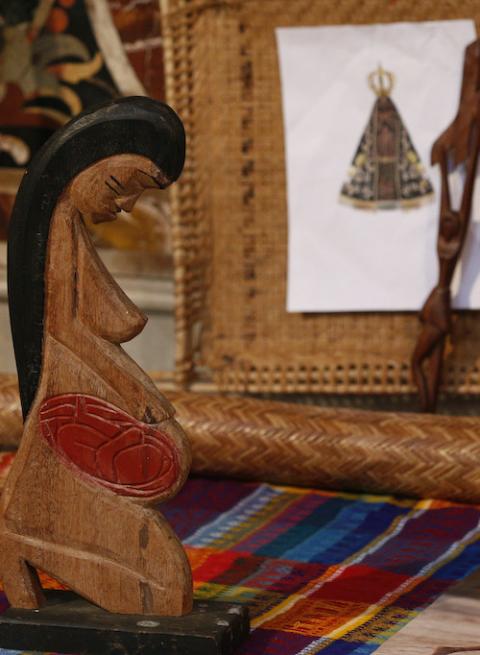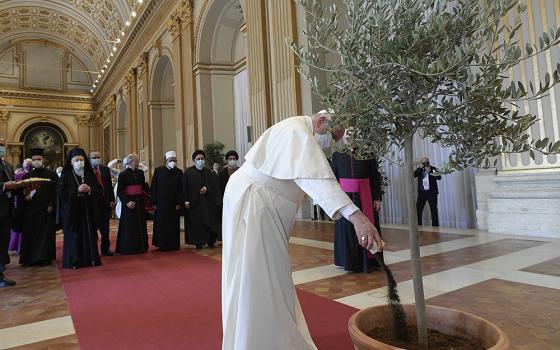
Pilgrims rest beside an image of Our Lady of Guadalupe Dec. 11, 2018, the eve of her feast day at the Basilica of Our Lady of Guadalupe in Mexico City. (CNS/Reuters/Carlos Jasso)
The trope that the future of the church can be found among young, conservative Christians has reared its hackneyed head again.
This past weekend, The New York Times dedicated a chunk of its Sunday review to a reported opinion piece suggesting that a small Twitter group who call themselves "Weird Christians" is the destiny of the faith. The writer, Tara Isabella Burton, claims that this movement, which seems very white, proudly old-fashioned, and unconsciously conformist, is somehow "punk."
"Modern life is ugly, brutal and barren. Maybe you should try a Latin Mass," says the sub-headline. "Veils! Veils! Veils!" cheers the accompanying graphics.
Burton counts herself among this virtual brood who find liturgies with "anachronistic language and sense of historical pageantry" a balm for their disillusionment with "the political binaries, economic uncertainties and spiritual emptiness that have come to define modern America."
But unlike many in their generation, they are seeking "a decidedly anti-modern vision of faith" to escape "the crisis of modernity."
And what precisely is this menacing modernism that makes young people want to flee to their nearest Gothic cathedral?
That's where the essay turns problematic.
Advertisement
Burton interviews Rod Dreher for the piece, suggesting that he is a founding father of the movement. In his book The Benedict Option, Dreher suggested that "Christians should abandon the culture wars and focus on living in intentional, godly communities."
The "modernism" that Dreher rebels against are the same old realities that most Christian radical traditionalists reject: justice and equality for women and LGBTQ persons, the acknowledgment of the presence and contributions of people of color, and any suggestion that Christianity is a global church. Dreher is Euro-centric to his bones and has a well-documented race problem.
Is this the modernism that Weird Christians have grown so weary of? Burton disingenuously skirts these issues.
Instead she tries to drive the point home that many Weird Christians are so progressive they are downright Marxist! But socialism — as we've seen in its young, white-male dominated form in the U.S. — does not inherently disassociate anyone from racism, misogyny, homophobia or transphobia. Many Catholics who pride themselves on their commitment to social justice have lots of work to do in these areas.
Burton also indicates that Weird Christians resent denominations that are diluting the "supernatural" aspects of the faith, like bodily resurrection, and they reject Episcopal and Lutheran churches that are "overly accommodationist" and "anodyne." One Weird Christian complains the lessons he learned in Catholic school were "simplistic" and "full of dumbed-down doctrine."
"Weird Christian," it seems, may be a euphemism for the spiritual elite.

A wooden statue of a pregnant woman is pictured in the Church of St. Mary in Traspontina as part of exhibits on the Amazon region during the Synod of Bishops for the Amazon in Rome Oct. 18, 2019. (CNS/Paul Haring)
Traditionalist Catholics, both young and old, have a remarkable sense that their religious devotions are somehow more intellectually rigorous and their spiritual desires deeper and vastly superior. Anything else is just pablum confected to pander to the great unwashed, namely feminists, LGBTQ folks and non-whites — those who seek "self-fulfillment via liberation to pursue one's desires," as one Weird Christian suggests.
Weird Christians claim to want a faith that is "totally demanding," but they do not seem inclined to do the demanding work of examining the relationship between the exaggerated medieval rituals they fetishize and the barbaric economic and social injustices of the Middle Ages.
They claim to want to be free of "political correctness," but every time a woman dons one of those veils, has she reckoned with the fact that head coverings were compulsory for centuries because the female body was seen as a threat to men's chastity?
As much as Weird Christians like to see themselves as somehow set apart from their generation, they simply aren't that unique. I do not know a millennial who isn't distressed by "unfettered capitalism" or the fusion of Republican politics and Christian churches. Most of them are longing for some sense of tradition and community and practices that connect them with something older and greater than themselves.
Many of these younger folks, myself included, understand the headiness of incense and the transporting allure of chant, too. We understand the power of holy objects, or "sacramentals" as Catholics call them. You cannot walk two steps in my apartment without glimpsing a rosary, a nativity, a retablo of women saints, a wood carving of a scene from the Gospels, even a small thurible.
Catholics have sacramentals because we believe that God's presence is in all of creation, and that through all things God reaches out to us inviting us into deeper relationship. Holy objects are meant to convey that God can be, and is, everywhere. But if these symbols and rituals are not communicating that kind of grace, they are nothing more than kitsch and camp.
The great sacramental theologian Franciscan Fr. Kenan Osborne once wrote:
We must find the Lord not only in the table of the Eucharist, but in the table of the world around us. If we do not see Jesus in the table of the world, we really will not find Jesus in the table of the Eucharist.
Sacrament and sacramentals are not about fleeing the world. They are about having the vulnerability to immerse oneself in the world and find God's presence everywhere, even in the "ugly, brutal and barren." We are meant to find transcendence through the world, not escape from it.
I'm not suggesting that we shouldn't seek respite and renewal in beauty, art and architecture. I certainly do. I am suggesting that, when you're in an old cathedral, you shouldn't only look up at the awesome ceiling and stained glass. You should also look down at the well-worn stone floor. Observe the grooves made by the feet of innumerable pilgrims who for centuries have come from every race and every corner of the Earth, bringing their questions, their suffering, their foolishness and their awe.
The same day that "Weird Christians" appeared in the print edition of the Times, a superb essay about Mary by Kaya Oakes appeared on Religion News Service. The piece is an insightful approach to Mary for those of us who reject the centuries-old characterization of her as pure, passive and obedient — the impossible standard by which the church judges all women.
Invoking the scholarship of St. Joseph Sr. Elizabeth Johnson, Oakes portrays Mary as "a radical visionary who sees a more equitable world as God's desire for humanity."
Oakes's essay is a perfect example of the ways in which ancient symbols and images can be employed to demand economic and social justice. She shows the way a feminist interpretation of Mary helps marginalized women to reclaim and redefine her as a liberator of all people. Her analysis also recognizes that Mary is the mother of a global church, as potent a symbol in Latin American, the Filipino and indigenous contexts as she is in Europe.
Mary is not a simplistic representation of perfection, Oakes reminds us, but has a multitude of depictions. She writes:
These images traveled around the world along with Christianity, and enabled people whose native religions were oppressed to adapt Mary in the image of their own indigenous goddess figures, meaning Mary is globalized but also localized, a symbol of the conquering religion subversively reinvented by the conquered.
Reading this, I could not help but think of the Pachamama statues that were stolen from a Roman church and batted into the Tiber river during the Amazon Synod in October 2019. I was in Rome at the time and was both devastated and enraged by this act of desecration, which was not only racist and misogynist, it reasserted the neocolonial, white supremacist mentality that is at the root of the destruction of the Amazon and its native peoples.
A few months after the Synod, Rod Dreher tweeted a selfie posing with Alexander Tschugguel, a young, Austrian male who claimed to be the one who desecrated the statues. (Interestingly, though the Vatican promised a full investigation, he never faced charges of theft or vandalism.) Dreher looks giddy and calls Tschugguel "the hero who threw Pachamama into the Tiber."
Dreher met Tschugguel in Rome at a conference that, according to NCR's Joshua McElwee, was led by "a coalition of right-wing nationalist groups from six countries" and warned, among other things, against "hegemonic progressivism." The conference's opening night speaker? Dreher himself. In the course of the evening, he sounded the alarm about a "pink police state" and called social justice a "utopian political cult."
If he is indeed the architect of Weird Christianity, those young folks have a lot of self-reflection to do.
[Jamie L. Manson is an award-winning columnist at the National Catholic Reporter. Follow her on Twitter: @jamielmanson.]
Editor's note: We can send you an email alert every time Jamie Manson's Grace on the Margins is posted to NCRonline.org. Sign up here.





